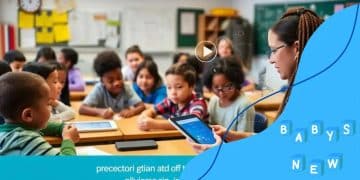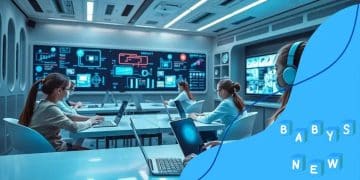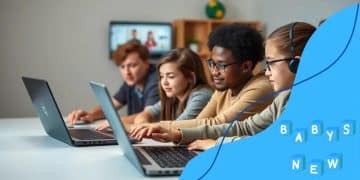How AR is being used for hands-on learning experiences
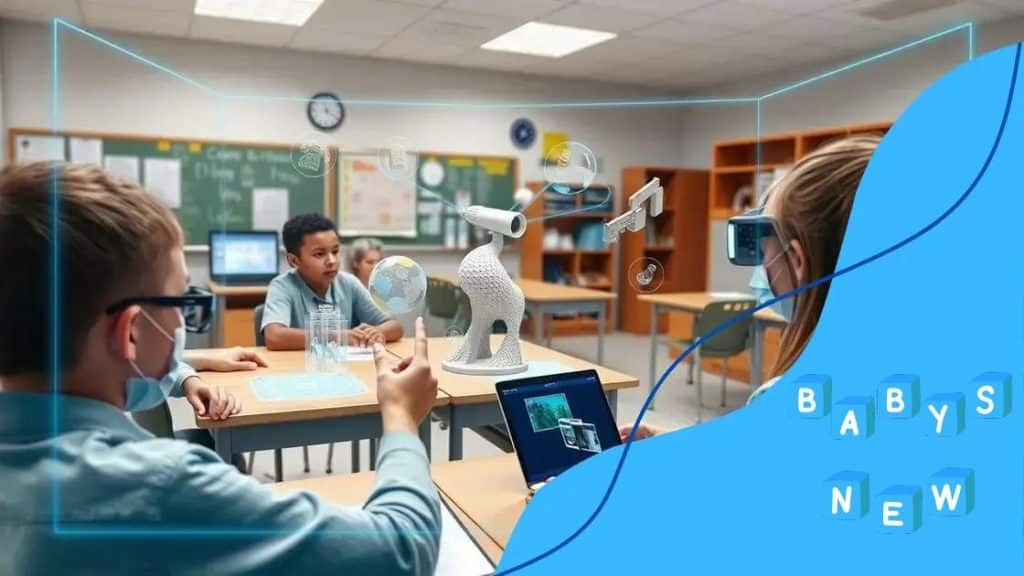
Advertisement
Augmented reality (AR) enhances hands-on learning experiences by providing interactive, personalized education that improves engagement, retention, and collaboration among students across various fields.
How AR is being used for hands-on learning experiences is transforming education. Imagine students interacting with 3D models right in their classrooms. What advantages does this bring to learning?
Understanding augmented reality in education
Understanding augmented reality in education is crucial as it opens new possibilities for interactive learning. By blending digital content with the real world, AR enhances student engagement and comprehension.
What is Augmented Reality?
Augmented reality is a technology that overlays digital information onto the physical world. This can be experienced through devices like smartphones and tablets. Students can explore 3D models, view animations, and interact with virtual elements, making the learning experience truly immersive.
Advertisement
Benefits of AR in Education
- Increased Engagement: Students are more likely to participate in lessons that utilize AR.
- Enhanced Understanding: Complex concepts become easier to grasp with visual aids.
- Personalized Learning: AR allows students to learn at their own pace, revisiting materials as needed.
Typically, traditional methods might not capture all students’ attention. In contrast, AR captures interest, making education more appealing. By integrating AR into lessons, educators can create a dynamic atmosphere where learning feels like an adventure rather than a chore.
Examples of AR in the Classroom
Classrooms adopting augmented reality often use apps that create interactive experiences. For example, virtual field trips take students to historical sites without leaving the classroom. Additionally, AR can help in science lessons, allowing students to visualize anatomy by viewing a 3D heart they can rotate and explore.
This transformative technology promotes collaborative learning. When students interact with AR content, they often work in groups, discussing and sharing their insights. This collaboration nurtures critical thinking and communication skills, essential for their future.
Advertisement
In summary, understanding how augmented reality reshapes education illustrates its potential to revolutionize the way students learn. Educators must recognize the benefits it brings and consider integrating it into their teaching strategies.
Key benefits of AR for hands-on learning
Exploring the key benefits of augmented reality (AR) for hands-on learning reveals how it positively impacts education. By engaging students in interactive experiences, AR makes complex topics easier to understand and retain.
Enhanced Engagement
One of the primary benefits is increased student engagement. When learners use AR, they connect with the material in a unique way. This technology allows them to interact with content that seems real, capturing their attention and encouraging participation.
Improved Retention of Information
Another significant advantage of AR in hands-on learning is that it significantly improves retention. When students see and engage with a concept through AR, they are more likely to remember it. For instance, visualizing a historical event with an AR application helps students recall facts better than traditional reading methods.
- Active Learning: AR promotes active participation, which aids memory retention.
- Multiple Learning Styles: It supports visual, auditory, and kinesthetic learners effectively.
- Real-World Applications: Students can see how classroom concepts apply in the real world.
Additionally, AR can cater to diverse learning styles. It supports visual learners with graphics, auditory learners through audio instructions, and kinesthetic learners by allowing hands-on interaction. This balance opens the door for every student to thrive.
Personalized Learning Experiences
Personalized learning is another benefit of AR technology. Students can learn at their own pace and revisit materials as needed. This adaptability encourages mastery of subjects rather than a one-size-fits-all approach, making education more effective and enjoyable.
By using AR, educators can tailor experiences to meet the needs and interests of their students. As a result, learners feel more empowered in their educational journey, fostering independence and confidence.
Overall, the use of augmented reality in hands-on learning creates a vibrant and effective educational environment. By promoting engagement, retention, and personalized learning experiences, AR is revolutionizing how students interact with knowledge.
Real-world applications of AR in training
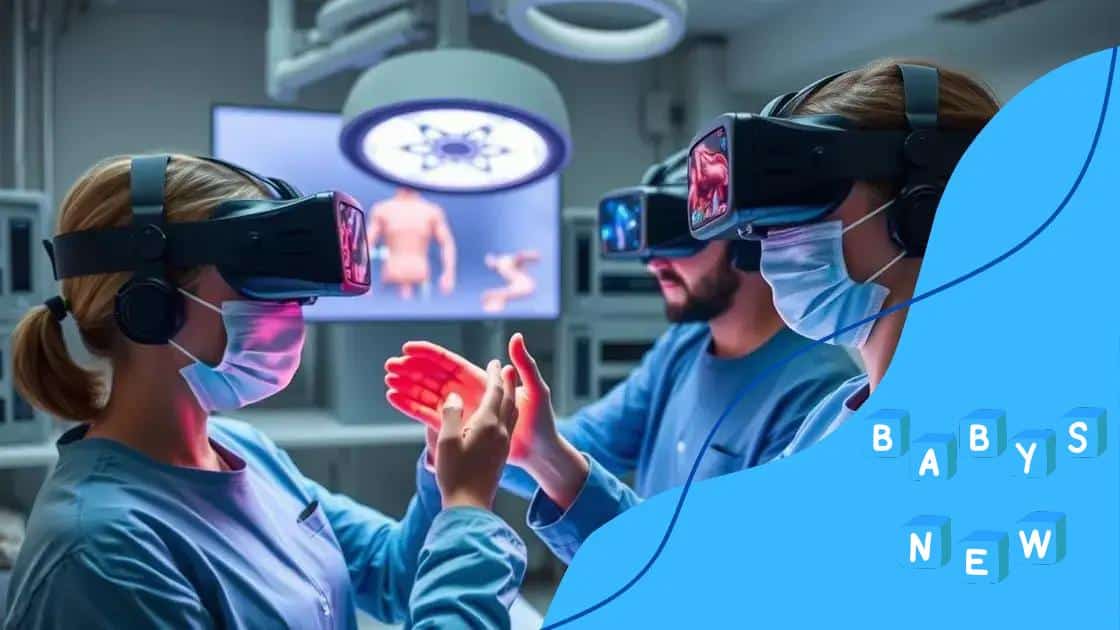
Real-world applications of augmented reality (AR) in training showcase how this technology enhances learning in various fields. By simulating real-life scenarios, AR provides trainees with practical experiences that improve skills and confidence.
AR in Medical Training
In the medical field, AR transforms how healthcare professionals learn and practice. Augmented reality can be used to visualize complex anatomical structures. Using AR headsets, medical students can interact with 3D models of human anatomy, helping them understand the body better and prepare for surgeries.
AR for Industrial Training
Industries such as manufacturing are leveraging AR for training purposes. Workers use AR overlays to see step-by-step instructions while performing tasks. This hands-on approach minimizes errors and boosts productivity, as employees learn in a real environment.
- Visual Instructions: Workers follow visual cues overlaid on machinery.
- Safety Training: AR simulations prepare employees for potential hazards.
- Process Efficiency: Trainees learn faster with guided AR experiences.
Additionally, AR enhances safety training in hazardous environments. By using realistic simulations, trainees can practice safety procedures without the risk of injury. This immersive training boosts their confidence and preparedness.
AR in Retail and Customer Service
Augmented reality also finds applications in retail training. Employees can learn to assist customers by practicing with AR scenarios. For instance, they can simulate customer interactions, helping them develop essential skills like problem-solving and communication.
Moreover, AR allows retail staff to familiarize themselves with products more effectively. By visualizing a product’s features through AR, employees can provide better assistance to customers, resulting in improved sales and satisfaction.
Overall, the real-world applications of augmented reality in training sectors emphasize its growing importance. From healthcare to retail, AR provides unique opportunities for hands-on learning, preparing individuals for success in their respective fields.
Challenges in implementing AR technologies
Implementing augmented reality (AR) technologies comes with several challenges that educators and organizations must navigate. While AR offers tremendous benefits, understanding the obstacles can help in developing effective strategies for integration.
Technical Infrastructure Requirements
One key challenge is the need for robust technical infrastructure. AR applications often require high-speed internet and powerful devices. Without adequate resources, both trainers and learners may experience delays or technical issues that hinder the effectiveness of the AR experience.
Cost of Implementation
The cost of AR technology can also be a significant barrier. Purchasing devices, software licenses, and developing content often requires substantial investment. Many schools and organizations may struggle to find the budget for these expenses, which can slow down or halt AR adoption.
- Device Costs: High-quality AR devices can be expensive.
- Development Costs: Creating custom AR content adds to overall expenses.
- Maintenance and Support: Ongoing costs for updates and technical support must also be considered.
Moreover, not all staff may be adequately trained to incorporate AR into their teaching or training. This lack of training can lead to ineffective use of the technology, making it crucial for organizations to invest in professional development.
User Resistance
User resistance is another challenge in implementing AR technologies. Some educators or employees may be skeptical about adopting new methods. This can stem from a fear of technology or a belief that traditional teaching methods are more effective.
To overcome this resistance, it is essential to provide clear information about the benefits of AR. Engaging users through demonstrations and pilot programs can help ease concerns and encourage acceptance.
Overall, understanding these challenges can help educators and organizations better prepare for implementing augmented reality technologies. By addressing technical, financial, and user-related factors, they can create a more seamless integration process.
Future trends in AR-enhanced education
Future trends in AR-enhanced education promise to revolutionize how students learn and interact with content. As technology advances, the applications of augmented reality in classrooms are expanding, making learning more engaging and effective.
Personalized Learning Experiences
One major trend is the move towards more personalized learning experiences. Augmented reality can adapt to each student’s needs, offering tailored content based on their learning pace and style. This customization helps students grasp difficult concepts and fosters a deeper understanding.
Collaboration and Social Learning
Collaboration in learning is another trend gaining traction. AR technologies can enable students to work together in virtual environments, even if they are physically apart. They can interact with shared 3D models and simulations, facilitating teamwork and communication skills.
- Remote Learning: Students can collaborate regardless of location.
- Interactive Group Projects: AR enhances team projects with real-time interaction.
- Peer Learning: Learners can teach each other in augmented environments.
This social learning aspect not only nurtures strong relationships among peers but also enhances critical thinking and problem-solving abilities.
Integration with Artificial Intelligence
Additionally, integrating augmented reality with artificial intelligence (AI) is expected to reshape educational experiences. AI can analyze student interactions with AR content to provide insights into their learning patterns. This information allows educators to adjust their approach, ensuring that all students receive the support they need.
For example, AI can suggest specific exercises in AR that target a student’s weaknesses while reinforcing their strengths. This level of personalized instruction can lead to better academic performance and greater student satisfaction.
Beyond the classroom, the use of AR in professional training is also on the rise. Industries are starting to adopt AR-driven training modules to prepare employees for real tasks. This practical training will likely become a standard practice in many professions, making transitions from education to work more seamless.
Overall, the future of augmented reality in education looks bright. With its ability to create interactive, engaging, and personalized learning experiences, AR is set to transform not just how students learn, but also how educators teach.
FAQ – Frequently Asked Questions about Augmented Reality in Education
What are the main benefits of augmented reality in education?
Augmented reality enhances engagement, fosters personalized learning, and promotes collaboration among students.
How can augmented reality be integrated into classroom learning?
AR can be implemented through apps that allow students to interact with 3D models and simulations, making complex subjects easier to understand.
What challenges might schools face when implementing AR technologies?
Challenges include costs, the need for technical infrastructure, and potential resistance from educators or students.
What future trends can we expect in AR-enhanced education?
Future trends include more personalized learning experiences, greater collaboration through virtual environments, and integration with artificial intelligence.


